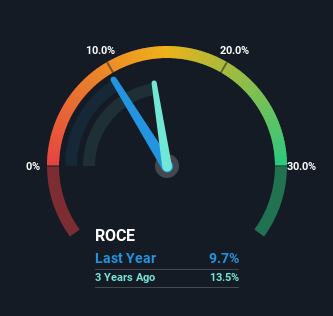- United Kingdom
- /
- Aerospace & Defense
- /
- LSE:QQ.
QinetiQ Group (LON:QQ.) Could Be Struggling To Allocate Capital

To find a multi-bagger stock, what are the underlying trends we should look for in a business? One common approach is to try and find a company with returns on capital employed (ROCE) that are increasing, in conjunction with a growing amount of capital employed. Put simply, these types of businesses are compounding machines, meaning they are continually reinvesting their earnings at ever-higher rates of return. However, after briefly looking over the numbers, we don't think QinetiQ Group (LON:QQ.) has the makings of a multi-bagger going forward, but let's have a look at why that may be.
Understanding Return On Capital Employed (ROCE)
For those that aren't sure what ROCE is, it measures the amount of pre-tax profits a company can generate from the capital employed in its business. To calculate this metric for QinetiQ Group, this is the formula:
Return on Capital Employed = Earnings Before Interest and Tax (EBIT) ÷ (Total Assets - Current Liabilities)
0.097 = UK£123m ÷ (UK£1.8b - UK£495m) (Based on the trailing twelve months to March 2022).
So, QinetiQ Group has an ROCE of 9.7%. On its own that's a low return on capital but it's in line with the industry's average returns of 9.7%.
See our latest analysis for QinetiQ Group

Above you can see how the current ROCE for QinetiQ Group compares to its prior returns on capital, but there's only so much you can tell from the past. If you'd like, you can check out the forecasts from the analysts covering QinetiQ Group here for free.
What The Trend Of ROCE Can Tell Us
On the surface, the trend of ROCE at QinetiQ Group doesn't inspire confidence. Around five years ago the returns on capital were 19%, but since then they've fallen to 9.7%. Meanwhile, the business is utilizing more capital but this hasn't moved the needle much in terms of sales in the past 12 months, so this could reflect longer term investments. It may take some time before the company starts to see any change in earnings from these investments.
On a related note, QinetiQ Group has decreased its current liabilities to 28% of total assets. So we could link some of this to the decrease in ROCE. Effectively this means their suppliers or short-term creditors are funding less of the business, which reduces some elements of risk. Since the business is basically funding more of its operations with it's own money, you could argue this has made the business less efficient at generating ROCE.
The Bottom Line
To conclude, we've found that QinetiQ Group is reinvesting in the business, but returns have been falling. Although the market must be expecting these trends to improve because the stock has gained 89% over the last five years. However, unless these underlying trends turn more positive, we wouldn't get our hopes up too high.
QinetiQ Group does have some risks though, and we've spotted 2 warning signs for QinetiQ Group that you might be interested in.
If you want to search for solid companies with great earnings, check out this free list of companies with good balance sheets and impressive returns on equity.
Valuation is complex, but we're here to simplify it.
Discover if QinetiQ Group might be undervalued or overvalued with our detailed analysis, featuring fair value estimates, potential risks, dividends, insider trades, and its financial condition.
Access Free AnalysisHave feedback on this article? Concerned about the content? Get in touch with us directly. Alternatively, email editorial-team (at) simplywallst.com.
This article by Simply Wall St is general in nature. We provide commentary based on historical data and analyst forecasts only using an unbiased methodology and our articles are not intended to be financial advice. It does not constitute a recommendation to buy or sell any stock, and does not take account of your objectives, or your financial situation. We aim to bring you long-term focused analysis driven by fundamental data. Note that our analysis may not factor in the latest price-sensitive company announcements or qualitative material. Simply Wall St has no position in any stocks mentioned.
About LSE:QQ.
QinetiQ Group
Operates as a science and engineering company in the defense, security, and infrastructure markets in the United Kingdom, the United States, Australia, and internationally.
Very undervalued with high growth potential and pays a dividend.
Similar Companies
Market Insights
Community Narratives



